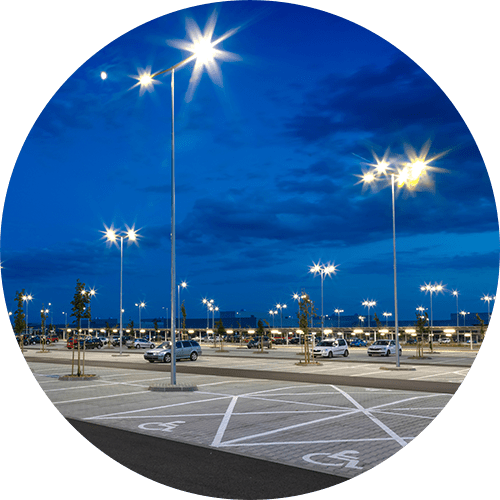The use of artificial light at night has far-ranging impacts for humans, plants, and animals alike.

Sky Glow
Sky glow from artificial light is likely a familiar sight to you – it is the cumulative scattering effect of man-made light sources that brighten the night sky and decrease your ability to see stars. The light pollution that causes sky glow may have consequences beyond suboptimal stargazing, including disrupting the circadian cycles of plants and animals, impeding the ability of nocturnal creatures to navigate their environment, reducing agricultural yields, interfering with astronomers ability to study the sky, and more.
LUNA Objective:
Reduce sky glow from artificial lighting by requiring LUNA products to meet uplight, dimming, and CCT thresholds.

Light Trespass
Light trespass occurs when light spills or “trespasses” into locations where it is not wanted or needed. An example of light trespass is illumination from streetlights entering the windows of a house or apartment. Light trespass also contributes to habitat disruption for animals and plants. While appropriate levels of light and shielded, optimized light distribution can alleviate many complaints of obtrusive light, these solutions also represent an opportunity to reduce light pollution and outdoor energy usage.
LUNA Objective:
Begin to eliminate disruptive light trespass by requiring LUNA products to meet dimming best practices and by offering efficacy allowances for products that use shields.

Glare
Glare occurs when light is scattered in your eyes from a particular angle of a light source or when light is too bright against the background. This can be painful or irritating, and it can also be very dangerous. When glare from a streetlight disrupts the vision of a driver or reflects off of a shiny surface, visibility is reduced and accidents on the road are more likely to occur.
LUNA Objective:
Continue to participate in standards development for glare so that appropriate and effective glare requirements can be incorporated into future versions of the LUNA program.

Negative Effects on Ecological Systems
Although artificial light has enabled us to increase our work and recreational activities outdoors at night, it has radically altered the nocturnal environment for many species. The widespread adoption of artificial lighting presents a growing threat to biodiversity in general, and nocturnally active wildlife in particular.
LUNA Objective:
Continue to develop strategies to minimize the adverse effects of artificial light at night, including the use of sensors and controls, light spectrum, and shielding.

Energy Savings
We cannot ignore the clear opportunity for energy savings when light is used only where and when it is needed. According to the International Dark-Sky Association, approximately $3 billion worth of energy is lost to sky glow each year. Installation of LUNA-compliant outdoor lighting introduces an opportunity to significantly reduce that number.
LUNA Objective:
Create a faster path for energy efficiency programs to meet their energy efficiency goals by reducing the amount of wasted energy consumed by outdoor lighting.
Goals of the LUNA Program
-

Minimize light pollution
The LUNA program introduces requirements for light distribution, correlated color temperature (CCT), and dimming controls that ensure less light is scattered into the atmosphere, resulting in reduction of light trespass and sky glow, and darker skies for stargazers, astronomers, and wildlife.
-

Minimize lighting energy use
In addition to meeting the efficacy thresholds of the DLC’s SSL V5.1 Technical Requirements, LUNA qualified products must meet additional dimming, control, and shielding requirements to ensure efficient use of lighting energy. These thresholds will help efficiency programs meet or exceed their energy savings goals and end users reduce operational costs.
-

Provide appropriate visibility for people
The LUNA program incorporates all SSL V5.1 spectral quality requirements, BUG reporting requirements, and additional spectral power distribution and intensity distribution reporting requirements, enabling lighting installations to meet recommended practices and voluntary guidelines for dark-sky best practices.
Who benefits from LUNA?
- Manufacturers looking to differentiate themselves by offering energy efficient AND dark sky friendly fixtures
- Utility and energy efficiency programs
- Commercial building owners and end users
- Cities, municipalities, road commissions and public works departments
- Lighting specifiers and designers
- ESCOs
- University sustainability officials
- National and state park decision makers
- Federal and state DOTs
How does LUNA work?
Led by the DLC, the LUNA program is guided by the LUNA Advisory Group, comprised of experienced lighting experts from the research, industry, design, and utility sectors. The panel provides perspectives and recommendations for criteria related to light at night that will allow users to differentiate products that minimize light pollution.
Products that achieve the LUNA qualification will be listed on the DLC’s Solid-State Lighting Qualified Products List (QPL). Lighting decision makers will be able to filter the QPL to show LUNA qualified products and may select from that list for their outdoor lighting projects. Additionally, LUNA qualified products will be identifiable by their use of the DLC LUNA product logo, released with the final Technical Requirements.
LUNA Technical Requirements Documentation
All documents related to the development of the LUNA technical requirements are available below.
© 2025 DesignLights Consortium. The DesignLights Consortium is a project of Efficiency Forward, Inc., a non-profit 501(c)3 organization. Privacy Policy Terms of Use
